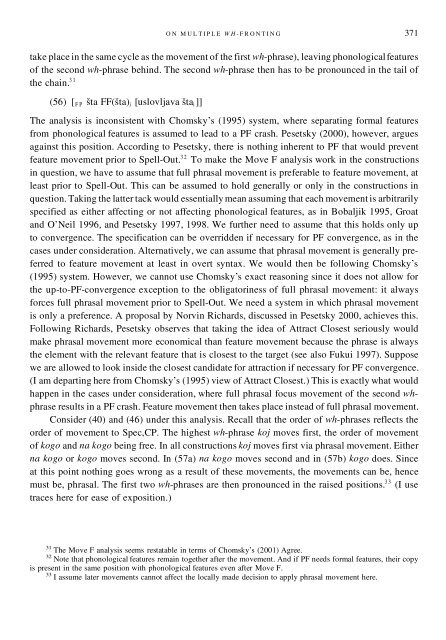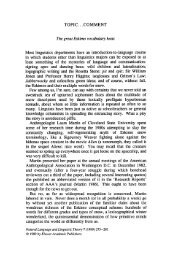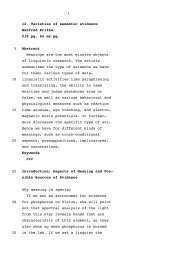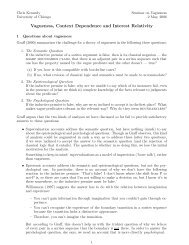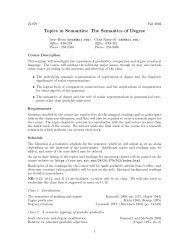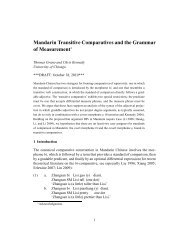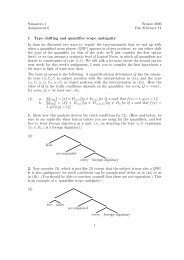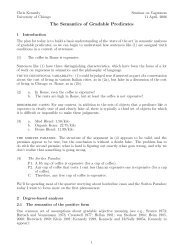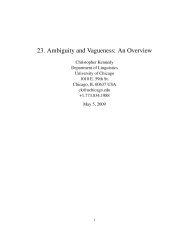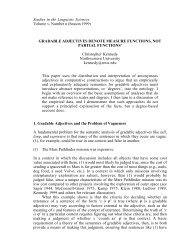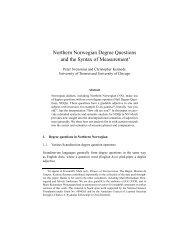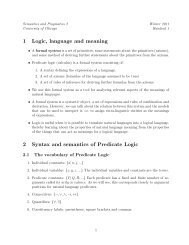On Multiple Wh-Fronting - University of Chicago
On Multiple Wh-Fronting - University of Chicago
On Multiple Wh-Fronting - University of Chicago
Create successful ePaper yourself
Turn your PDF publications into a flip-book with our unique Google optimized e-Paper software.
O N M U L T I P L E W H - F R O N T I N G 371take place in the same cycle as the movement <strong>of</strong> the first wh-phrase), leaving phonologicalfeatures<strong>of</strong> the second wh-phrase behind. The second wh-phrase then has to be pronounced in the tail <strong>of</strong>the chain. 3 1(56) [ F P sÏ ta FF(sÏ ta) i [uslovljava sÏ ta i ]]The analysis is inconsistent with Chomsky’s (1995) system, where separating formal featuresfrom phonological features is assumed to lead to a PF crash. Pesetsky (2000), however, arguesagainst this position. According to Pesetsky, there is nothing inherent to PF that would preventfeature movement prior to Spell-Out. 3 2 To make the Move F analysis work in the constructionsin question, we have to assume that full phrasal movement is preferable to feature movement, atleast prior to Spell-Out. This can be assumed to hold generally or only in the constructions inquestion. Taking the latter tack would essentially mean assuming that each movement is arbitrarilyspecified as either affecting or not affecting phonological features, as in Bobaljik 1995, Groatand O’Neil 1996, and Pesetsky 1997, 1998. We further need to assume that this holds only upto convergence. The specification can be overridden if necessary for PF convergence, as in thecases under consideration. Alternatively, we can assume that phrasal movement is generally preferredto feature movement at least in overt syntax. We would then be following Chomsky’s(1995) system. However, we cannot use Chomsky’s exact reasoning since it does not allow forthe up-to-PF-convergence exception to the obligatoriness <strong>of</strong> full phrasal movement: it alwaysforces full phrasal movement prior to Spell-Out. We need a system in which phrasal movementis only a preference. A proposal by Norvin Richards, discussed in Pesetsky 2000, achieves this.Following Richards, Pesetsky observes that taking the idea <strong>of</strong> Attract Closest seriously wouldmake phrasal movement more economical than feature movement because the phrase is alwaysthe element with the relevant feature that is closest to the target (see also Fukui 1997). Supposewe are allowed to look inside the closest candidate for attraction if necessary for PF convergence.(I am departing here from Chomsky’s (1995) view <strong>of</strong> Attract Closest.) This is exactly what wouldhappen in the cases under consideration, where full phrasal focus movement <strong>of</strong> the second whphraseresults in a PF crash. Feature movement then takes place instead <strong>of</strong> full phrasal movement.Consider (40) and (46) under this analysis. Recall that the order <strong>of</strong> wh-phrases reflects theorder <strong>of</strong> movement to Spec,CP. The highest wh-phrase koj moves first, the order <strong>of</strong> movement<strong>of</strong> kogo and na kogo being free. In all constructions koj moves first via phrasal movement. Eitherna kogo or kogo moves second. In (57a) na kogo moves second and in (57b) kogo does. Sinceat this point nothing goes wrong as a result <strong>of</strong> these movements, the movements can be, hencemust be, phrasal. The first two wh-phrases are then pronounced in the raised positions. 3 3 (I usetraces here for ease <strong>of</strong> exposition.)31 The Move F analysis seems restatable in terms <strong>of</strong> Chomsky’s (2001) Agree.32 Note that phonological features remain together after the movement. And if PF needs formal features, their copyis present in the same position with phonological features even after Move F.33 I assume later movements cannot affect the locally made decision to apply phrasal movement here.


